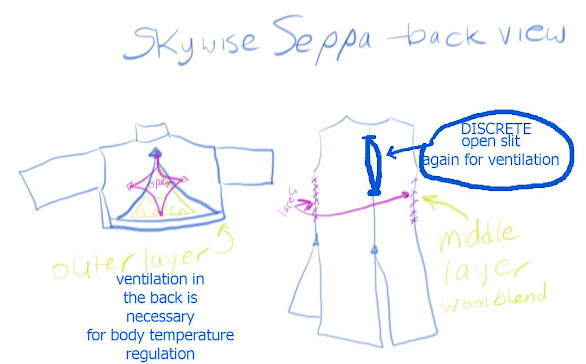Finally, LARP-life resumes.
After taking and wearing the kit that I'd made for Skywise Seppa to the few player events, and then seeing how sloppy ey looked, I ditched what I made and paid someone who knows what they're doing. That someone is Goldenmochi Costumes & Designs.
They took my crude sketches and turned them into excellent clothes for my orc to wear. Goldenmochi made a hood, a jacket, two tabards, a tunic, and a toilet skirt. If you're wondering what a toilet skirt is, it's a unisex garment to facilitate using the toilet without all your costume ending up filthy from the floor or entering the toilet; I was inspired by the underskirt brides use to contain all their dress's fluff when they need the toilet.
At this stage, I sorta knew, but didn't know, what I wanted or needed. I hadn't truly played my character.
What I did, was present them with a variety of fabrics and they did the magic of making things from the fabrics and my sketches.
I also had some stuff already, such as the trousers and the gaiters. Some of the things in the sketch above turned out not to work, so they got swapped or discarded entirely.
I do have temperature regulation issues, so I had to design some ventilation in my garments so that I wouldn't overheat. My orc mask completely covers my face and neck. Normally, the orc brief wants one to cover neck and hands with wraps, but as I overheat too easily (and then a few minutes after that, I'm freezing, then a few minutes later, I'm boiling again, ad nauseum) I had to find a workaround.
I ended up with the star pattern, rather than the triangle pattern for the back of the jacket.
The jacket/bolero has open armpits to allow me the multiple layers for insulation from cold and wind and heat. The high, stiffened collars of the tunic and jacket do the job of hiding the mask's lower end around my neck.
For the tunic and the jacket, I went with cotton, the optional middle layer - the tabard - is polyester/wool blend fabric to give me warmth if the weather's chilly. The toilet skirt is heavyweight calico cotton. Note, I probably ought to have gone with a half-circle rather than full circle and gone for a lightweight calico instead of a heavyweight calico, for that toilet skirt. However, I didn't know my mistake until I finally made it to Anvil.
As to the warskirt, I'm still using the one that I made. Between E1 (April 2022) and E2 (June 2022), I did adjust and adapt the warskirt. I replaced the two panels from being on separate cotton twill tapes to being together on a narrow leather belt. It makes it a lot easier to quickly don the warskirt.
I bought some Wyrmwick 'chitinous' bracers/vambraces/forearm armour in 'ivory' colour. If I do become a battle mage, these will be part of that armour.
I've realised that I can't wear the gambeson, it's far too hot with all the other layers. If I need warmth, I'll wear thermals underneath my kit.
I love the hood. E1 was sunny, dry, but chilly due to the wind, and colder at night. I did resort to the middle layer during the day along with thermals, and kept reasonably comfortable. The hood kept my head from getting too cold, and provided shade from the sun, and I could do a face-time without having to completely withdraw from playing with others.
At E2, the weather started out a bit drizzly and damp and cool, but once the rain clouds cleared after Friday, it became hot and dry. The hood then protected me from boiling my brain inside my mask. I didn't need the thermals nor the middle layer, and I had to put aside the toilet skirt as too cumbersome. I also wore the Mytholon 'matey' shorts for part of Friday because I really was simply too warm.
The picture above is from one of Goldenmochi's progress pictures that shows the back ventilation.
I just discovered someone (Paul Baker) did get a close-up picture of me at E1. Yep, I'm the less glamourous orc on the left. The other orc is Skywise Tulva, whose physrep is an amazing player and was generous enough to allow me to tag along for portions of E1. I did re-arrange the belts' contents between E1 and E2. I'm still trying to figure out what is and what isn't working, and trying to streamline without compromising interesting visual details.
In the above photograph, I'm wearing the hood, the jacket, the middle layer, the toilet skirt, and I may have also had the thermals underneath it all, because it was windy.
At E2, and I apologise for bouncing around, I'm just delighted to learn that there are several pics of me as an orc now floating around.
Below are some pictures from E2. I felt well enough to take the battlefield and also drum for my nation, I don't do actual fighting, but I wanted to help contribute something.
Andrea Martin is the photographer of the next picture.
It was a hot day, but that generous hood kept me from getting cooked, the layers of clothes did their job of keeping me from getting too heated. In this one, I only have the tunic, the jacket, and the hood for the upper body layers. The lower layers were the 'hero pants', the gaiters, and the warskirt. The thin leather belt dangling down is the replacement for the strings that held the warskirt.
I won't lie, I was warm, but I wasn't hot and I made sure to keep drinking water often. I didn't roll with sweat but I did get a little bit of perspiration in my mask, rather than condensation.
I have begun customising the jacket for E3; so I'll have changed things again.









































